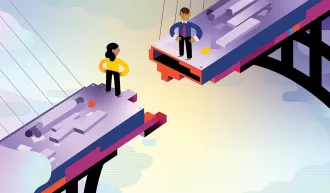George Kurian | Photograph by David Paul Morris
The recent rebound of Sunnyvale data storage giant NetApp is one of Silicon Valley’s more remarkable turnaround stories, much the same as the story of the CEO behind it, 1995 Stanford Graduate School of Business alum George Kurian.
Born to a successful manufacturing entrepreneur and a no-nonsense, college-educated mother in Kerala, India, Kurian also holds an electrical engineering degree from Princeton. After a career in networking that included key roles at Oracle, Cisco, and Akamai, Kurian joined NetApp in 2011 as senior vice president of its storage solutions group. He was promoted to executive vice president for product operations in 2013, and to CEO in 2015 after the struggling company’s board asked his predecessor to step down.
NetApp has grown under Kurian’s leadership. Revenues for fiscal 2017 were $5.52 billion, with income of $509 million, up from $229 million the year before. On the day he spoke with us, NetApp stock was trading above $40 per share, up from a 52-week low of $22.89.
Kurian’s career has been paralleled by that of his twin, Thomas, who also attended Princeton and Stanford. Thomas has spent nearly 20 years at Oracle and now is the company’s vice president of product development.
We asked Kurian to share with us the key lessons he’s learned along the road to the CEO’s chair.
Since 2015 you’ve sat on the top rung of the corporate ladder at a multibillion company, but are there times when you still feel like an entrepreneur?
Every multibillion-dollar technology company has an amazing portfolio of capabilities, some of which are still incubating from a technological or business perspective, so you’re always trying to remain entrepreneurial in creating new business. In NetApp’s case, we had to create a new solid-state storage business from nothing, and to succeed at that we had to behave and act like entrepreneurs.
You’ve credited NetApp’s rebound to “continued focus and disciplined execution.” Why were those key?
We succeed when everybody in the company is enormously clear about our most important priorities — to focus on solid-state storage, and to address this trend toward the cloud. So we aligned our communications and marketing strategy so that everybody was clear that those were the priorities. As a result, we’ve grown at faster rates than anyone in those markets. From an execution standpoint, we have a closed-loop performance management model and we’re constantly looking at barriers to success — and taking corrective action. Now we have weekly meetings where we review our priorities and keep track of where we are. Often you see action being taken on those decisions by the following week. We want to make decisions at pace, with sufficient information but not necessarily all information. That speed is absolutely necessary in this industry, and our approach is starting to prove out.
You’re an electrical engineer who started in 1990 as a coder at Oracle. Was it hard going from engineer to executive?
My dad and brother were an important part of that transition, because they’re both engineers who moved to the business side of things. They taught me that the breadth of things an executive has to deal with is wider than that of an engineer. I also had to learn to deal with uncertainty. With engineering, there’s often a black-or-white answer. But as an executive, that’s much rarer. If you wait for certainty, you’re almost always too late.
You had to lay off nearly 1,500 NetApp employees in February 2016. What did you learn from that?
We had a business that had gone sideways in terms of revenues. The operating margins were a little over 7%, but the prior leadership team had told Wall Street our margins would be between 16 and 18%. The majority of our costs are in people, so there was literally no choice but to have to make a tough set of decisions. Once you’ve made up your mind that’s what you have to do, it becomes a matter of honoring both the people who stay and the people who lose their jobs.
You once advised, “Be humble about knowing you are not expert in all disciplines.” How does that play out in your daily life?
One of the mistakes you make when you’re the leader of a large institution is in thinking you have better judgment than everyone else in the room. The fact is, your experts are enormously more capable than you are. As leader, you can bring perspectives that the experts may not have, but I always challenge our teams to take the lead.
Most of your career was spent in networking. What was the appeal of the data-storage business?
From an intellectual standpoint, it was a chance to learn new things. In the first few months, I knew nothing about storage and had legitimate reasons to ask a lot of stupid questions. If you have the humility to accept your lack of knowledge, you can learn a lot.
How did you address the disruption that cloud storage brought to the storage industry?
Market transitions are the reality of the tech industry, and frankly of the whole business landscape. It’s the idea of creative destruction: Out of one industry comes another that transforms the prior industry or destroys it. It’s especially hard for tech companies. Technologists who love one type of technology or business model have a hard time saying, “That’s over.” But you have to disrupt yourself to be seen by your customers as having merit in that new world.
What qualities are you looking for when recruiting for executive positions at NetApp?
We look for leaders who can inspire, motivate, and transform teams to succeed. We look for people who are collaborative, and we have a high bar on ensuring that our values and principles are fostered while the organization renews itself in ways that embody those principles. It’s a delicate balance.
Any single book that profoundly influenced you?
I don’t remember the title or the author, but I most remember a little volume about Abraham Lincoln, who is one of the leaders I admire and respect. My mother gave it to me when I was 8 years old. I read it over and over and kept it under my pillow at night. I still remember his self-reliance and his ability to empathize and learn from people.
For media inquiries, visit the Newsroom.






